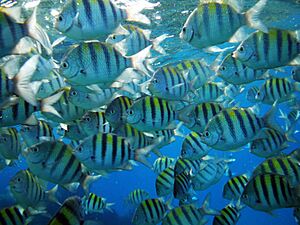Sergeant major (fish) facts for kids
The sergeant major or píntano (Abudefduf saxatilis) is a type of damselfish. This colorful fish can grow up to about 23 centimeters (9 inches) long. It gets its name from the bold, striped patterns on its sides, which look a bit like the stripes on a military sergeant major's uniform.
Quick facts for kids Sergeant major (fish) |
|
|---|---|
| Sergeant major swimming inshore at Phil Foster Park, Florida | |
| Conservation status | |
| Scientific classification |
Contents
Where Sergeant Majors Live
The sergeant major fish lives in the Atlantic Ocean. You can find them in many places:
- Along the eastern coast of the United States, south to the Gulf of Mexico.
- Around the Bahamas and islands in the Caribbean Sea.
- Off the eastern coasts of Central and South America, all the way to Uruguay.
- In the eastern Atlantic, from Portugal to western Africa, including the Azores, Canary Islands, and Cape Verde.
Young sergeant majors often hang out in tide pools. Adult fish prefer coral reefs. They can be found in waters from the surface down to about 40 meters (130 feet) deep.
What Sergeant Majors Look Like
Sergeant majors usually grow to about 15 centimeters (6 inches) long, but some can reach up to 23 centimeters (9 inches). The heaviest one ever recorded weighed about 200 grams (7 ounces).
These fish are mostly white with a yellow top. They have five dark, vertical stripes that can be black or dark blue. Sometimes, you might see a very faint sixth stripe near their tail. Adult males often look more bluish, and their stripes are less noticeable. They also have a dark spot near their pectoral fin (the fin on their side).
Sergeant Major Behavior

Sergeant majors often swim together in large groups called shoals. These shoals can have hundreds of fish!
Sometimes, other fish help clean parasites off sergeant majors. These "cleaner fish" include types of gobies, as well as Bodianus rufus, Elacatinus figaro, and Thalassoma noronhanum. Sergeant majors also help clean green sea turtles, along with other fish like Acanthurus chirurgus and Acanthurus coeruleus.
What Sergeant Majors Eat
Sergeant majors have a varied diet. They eat:
- Tiny young invertebrates (animals without backbones).
- Zooplankton (small animals that drift in the water).
- Smaller fish.
- Crustaceans (like tiny crabs or shrimp).
- Different kinds of algae.
They have even been seen eating waste and vomit from spinner dolphins!
Who Eats Sergeant Majors?
Several larger fish prey on sergeant majors. These predators include:
- Plectropomus leopardus (a type of grouper).
- Thalassoma bifasciatum (a bluehead wrasse).
- Cephalopholis cruentata (a graysby).
- Epinephelus striatus (a Nassau grouper).
- Mycteroperca venenosa (a yellowfin grouper).
- Rachycentron canadum (a cobia).
Sergeant Majors in Aquariums
You can sometimes find sergeant majors in the aquarium trade. However, they are considered difficult to breed in captivity.
Reproduction and Life Cycle
Sergeant majors lay eggs, which means they are an oviparous species. The males play a big role in setting up a home for the eggs.
- Males create nests on rocks, coral reefs, old shipwrecks, or pilings.
- Females then lay their eggs in these nests.
- A female can lay about 200,000 oval-shaped eggs, which stick to the surface of the nest with a thin thread.
- After a few days, the eggs turn a greenish color.
- The male guards the eggs carefully for about a week. While he is guarding, his body often turns a bluish color.


